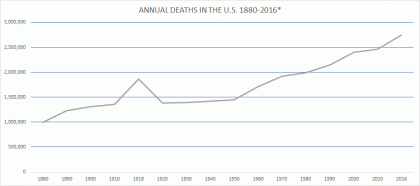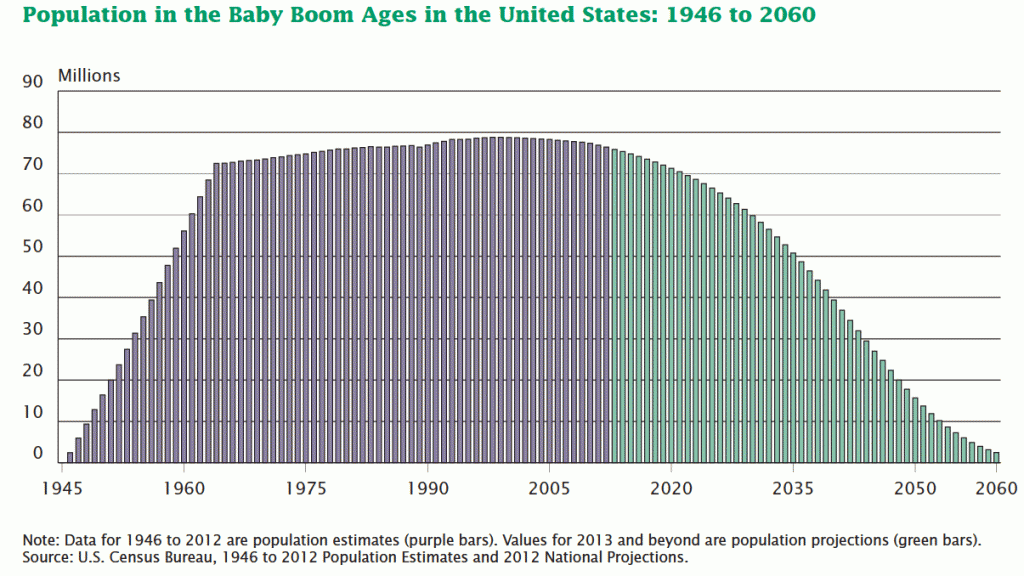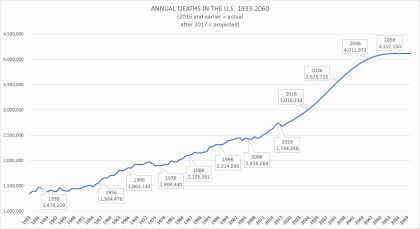From this picture of the past and future, what can we learn about the the funeral market in the United States?

(*1880-1930, death registration area death rate applied to total U.S. population count. See below.)
Throughout human history, changes in the big picture environment of a group of people have often led to changes in the way those people live. Changes in social structure leading to changes in culture. Macro affecting micro.
Population increases and decreases would be quintessential examples of the big picture. If a bunch of people start moving into a neighborhood, or leaving, people within that area might end up doing things differently.
An institution like whichever one happens to handle the dead within a given society, being very population-dependent, can be susceptible to changing when there are major demographic shifts. This seems like an obvious sort of observation, but it hasn’t been explored much, especially in the modern context.
Patterns emerge from changes in death totals that should be of interest to anyone concerned with the funeral business, not least of all people working in that industry.
It will take more than a few posts to tell this story, but a key part can be explained very simply by showing what sort of market the first few generations of American funeral directors inhabited.
To skip ahead briefly, however: I will point out that the American funeral industry took shape in the second half of the nineteenth century, first in some of the larger eastern cities, and had become dominant throughout the entire U.S. by the beginning of World War II. Some rural areas such as in Appalachia did not have ready access to modern embalming until the early 1940s. But for present purposes, I will note that the funeral business was functioning in many of our major population areas from the 1880s onward.
As mentioned in a previous post, we don’t have complete death statistics from before 1933. But we can do a bit of extrapolation using data we do have to get a fuller picture of death in America. In the early years of mortality counting, from 1880 through 1933, the agencies responsible designated a “death registration area” that began with just a few cities but gradually encompassed the entire country. The death registration area death rates are shown in the early years of the 1880-2060 chart posted earlier.
I think the death registration area death rates were probably not too far off from the situation in the rest of the U.S. If we multiply those validated death rates by the actual U.S. population totals for those years from the previous post, we get the following:
*Estimated deaths in U.S., 1880-1930, applying death rate from death registration area to total U.S. population
| 1880 |
50,155,783 |
19.8 |
993,085 |
| 1890 |
62,947,714 |
19.6 |
1,233,775 |
| 1900 |
76,094,134 |
17.2 |
1,308,819 |
| 1910 |
92,406,536 |
14.7 |
1,358,376 |
| 1918 |
103,202,801 |
18.1 |
1,867,971 |
| 1920 |
106,466,420 |
13 |
1,384,063 |
| 1930 |
123,076,741 |
11.3 |
1,390,767 |
(I include the out-of-series year 1918 as a matter of interest to show the affect the Spanish flu had, but also because, as a part of the funeral business landscape, 1918 shouldn’t be overlooked).
Let’s take a look at the graph at the top. (Full data list is below):
Continue reading U.S. Mortality Totals During The Funeral Industry’s Early Years →



